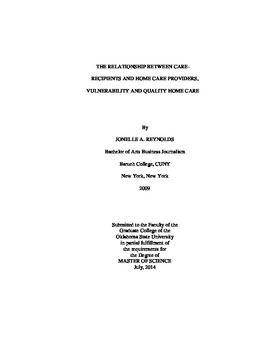| dc.description.abstract | Americans are living longer so the number of citizens 65 and older is expected to increase at a rate never before seen. In 2012, about 8.7% of older adults lived below the poverty level. Low- income adults are eligible for the Medicaid ADvantage in-home services that help clients remain in their homes instead of moving to nursing care facilities.The purpose of this study was to examine differences among the Medicaid ADvantage population (gender, geographical location,) on their ratings of relationship quality with personal care assistants [PCAs] and case managers [CMs] and also on their ratings of home care quality. It is also to examine the role of multiple vulnerability factors (gender, age, race, activities of daily living, ADLs, and instrumental activities of daily living, IADLs) in predicting home care quality and PCA relationship quality. Three types of analyses were used to investigate the experiences of care-recipients in the ADvantage program. First, t-tests were used to compare gender with PCA relationship quality, CM relationship quality and home care quality. Second, a one-way ANOVA was used to compare PCA relationship quality by geographical location (urban, mixed and rural counties); CM relationship quality and PCA home care quality. Third, a linear multiple regression was used to determine the predictive power of vulnerability (i.e., a combination of gender, age, race, ADLs and IADLs) on PCA relationship quality and home care qualityThe results did not fully support the research hypotheses used in this study. However, the results from the regression did confirm that one factor (age) significantly predicted home care quality. Although significance was not found in each hypothesis, lack of significance proved to be important findings for the Medicaid ADvantage program.Future research is recommended to conduct more in depth qualitative investigations of this population using objective measures of social support, vulnerability and home care quality. Clinical implications were that Marriage and Family Therapy programs ensure that their curricula prepare students to competently deal with the needs of this aging population by increasing their knowledge in aging issues and equipping them to work in diverse settings like assisted living facilities. | |
